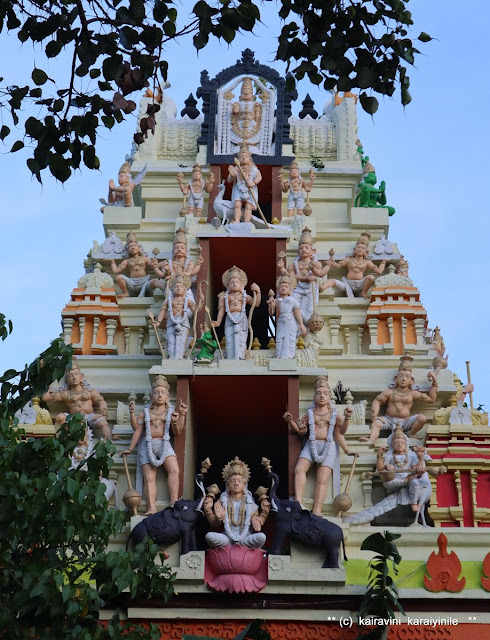Some places carry a wrong perception, primarily for the way they are portrayed in movies. The temple city of Madurai is often portrayed in Tamil movies as violent city with gangsters walking with ‘aruvals’ clutched behind their necks inside their white shirts ! .. .. Vijayawada is another one ! “Bezjawada” produced by Ram Gopal varma and directed by Vivek Krishna hit the screens in 2011 and did not do all that well – this Telegu film was on the Vijayawada Gang Warfare, featuring Naga Chaitanya and Amala Paul in the lead roles. Later it was dubbed in Hindi as Hero: The Action Man and also in Tamil as Vikram Dhadha. No filmy review this !
In some legends, Vijayawada is referred to as Rajendracholapura as Virarajendra Chola won a battle against Chalukyas in 1068 and ruled over this place. The reason for the city acquiring the name Bezawada is that Goddess Krishnaveni (River Krishna) requested Arjuna to make a passage for her to merge into the Bay of Bengal. Arjuna made a bejjam (hole) through the mountains and the place came to be known as Bejjamwada which later changed to Bezawada. Other names of Vijayawada were being Vijayavata, Beejapuram, Kanakaprabha, Kanakapuram, Kanakawada, Jayapuri, Vijayapuri, Phalguna Kshetram and Jananathpura. Bezawada (as Vijayawada was known then) was founded around 626 A.D. by Paricchedi Kings. Bezawada (Vijayawada) was ruled by King Madhava Varma (one of the kings of Vishnukundina dynasty). Chinese Buddhist scholar Xuanzang stayed a few years in Bezawada around 640 A.D. to study the Abhidhamma Pitaka. In the early 16th century, during the reign of Qutb Shahi dynasty (Golconda Sultanate), diamond mines were found near Vijayawada on the banks of Krishna River.Any traveller via Vijayawada cannot miss Prakasam barrage – over river Krishna. River Krishna, is the fourth longest river which flows entirely in India, after the Ganges, Godavari and Narmada. One for sure would love to stand near the gate and view the long bridge on this river nearer Bejawada [Vijayawada station]. Krishna River flows about 1,400 kilometres (870 mi), originating at Mahabaleswar near the Jor village in Satara District, Maharashtra and meets Bay of Bengal at Hamasaladeevi in Andhra Pradesh, flowing through Karnataka before entering Andhra. The delta of this river is one of the most fertile regions in India and was the home to ancient Satavahana and Ikshvaku Sun Dynasty kings.
Earlier known as Bezawada, Vijayawada is a Commercial city with a hot climate – you can feel the heat as the train enters this region ~ Indian Railways has assigned the station code - "BZA". This politically active city is well connected by road, air and more specifically by rail. It is a major Railway junction located in South Central Railway. Trains from Tamilnadu towards Hyderabad pass through ~ trains to Howrah & beyond; the National Capital and beyond – all pass through this Junction. The station has 10 platforms and is one of the busiest with more than 250 express and 150 freight trains passing through it. The station was constructed in 1888 when the Southern Maharatta Railway's main eastward route was connected with other lines going through Vijayawada. By some accounts, an average of 70,000 people board different trains each day and an equal number of commuters exit trains at the station.
Vijayawada is a holy town – with the famous temple of Sri Kanaka Durgamma of Goddess Durga – Pushkaram on river Krishna occurs here once in 12 years. It is also called Vijayavatika (land of victory in Telegu) where Goddess Durgamma killed demon Mahisashura, and resting at Indrakeeladri hill by the river side – establishing victory of good over evil and providing boons to all devotees.
கவிச்சக்ரவர்த்தியின் கம்ப இராமாயணம் ஓர் அற்புத காவியம். உயர்ந்த இலக்கிய நடை, உன்னதமான பக்தி, அற்புதமான சொல்லாடல், அழகு பொங்கும் கருத்துகள் மிகச்சரியான உவமானங்களோடு .. .. இதோ இங்கே : கம்பராமாயணத்தின் யுத்த காண்டத்தின் ஆரம்ப பாடல் :
'ஒன்றே' என்னின், ஒன்றே ஆம்; 'பல' என்று உரைக்கின், பலவே ஆம்;
'அன்றே' என்னின், அன்றே ஆம்; 'ஆமே' என்னின், ஆமே ஆம்;
'இன்றே' என்னின், இன்றே ஆம்; 'உளது' என்று உரைக்கின், உளதே ஆம்;
நன்றே, நம்பி குடி வாழ்க்கை! நமக்கு இங்கு என்னோ பிழைப்பு? அம்மா!
மேலுழுந்தவாரியாக முதல் தடவை படிக்கும்போது - இந்த பாட்டு சற்று குழப்பமான அர்த்தங்களை தரலாம். எம்பெருமான் அளப்பிலரியன், அவன் எங்கும் உளன், அவனை பல ரூபங்களில் காணலாம் - எனினும் அவன் ஒருவனே எனும் பரமார்த்த தத்துவத்தை மிக எளிமைய விளக்கியுள்ளார் கம்ப நாட்டாழ்வார். கம்பன் வினவுவது : ஒன்று என்று கூறினால் ஒன்றேயாகும்; பல என்று கூறின் பலவாகும்; இத்தன்மை உடையதல்ல என்று கூறினால் அவ்வாறே ஆகும் ; இன்ன தன்மைதான் உடையது என்று கூறினால் அந்தத்தன்மை உடையதாயிருக்கும்; .. .. .. இப்படிப்பட்ட இறைவனது நிலை பெரிதாயுள்ளது; அற்ப அறிவுடைய சிற்றறிவினராகிய நாம் இவ்வுலகில் இறை நிலையை அறிந்து உய்வு பெறும் வழி யாது?
'உலகம் யாவையும் தாம் உளவாக்கலும், நிலை பெறுத்தலும் நீக்கலும் நீங்கலா அலகிலா விளையாட்டுடைய பரமன் ஒருவனே ஆதலின் 'ஒன்றே என்னின் ஒன்றேயாம்' என்றார். அந்த ஒரு பரம் பொருளே, 'திட விசும்பு, எரி, வளி, நீர், நிலம் இவை மிசைப்படர் பொருள் முழுவதுமாய் அவை அவை தோறும், உடல்மிசை உயிர் என கரந்து எங்கும் பரந்துள்ளதாதலின், "பல என்று உரைக்கில் பலவே ஆம்" என்றார். 'ஒன்றெனப்பலவென அறிவரும் வடிவினுள் நின்ற நன்றெழில் நாரணன்" என்று திருவாய் மொழி இங்கு ஒப்பு நோக்கத்தக்கது. கண்ணுக்குப் புலப்படாத அவ்விறைவனைக் காணப்படும் பரிதி, மதி போன்றவற்றைக் காட்டி "இதுவல்ல, இதுவல்ல" என்று சுட்டி அறிவிக்க வேண்டியிருப்பதால் "அன்றே என்னின் அன்றே ஆம்" என்றார். அப்பரமனின் இயல்பை !!
எம்பெருமான் உறையும் திருக்கோவில்களுக்கு - திவ்யதேசங்களுக்கு, முக்கிய திருக்கோவில்களுக்கு சென்று - அங்கு அவ்விடத்திலே எம்பெருமானை தரிசித்து, கைங்கர்யங்கள் செய்து இன்புறுகிறோம். சமீபத்தில், பத்ரசாலம் ஸ்ரீராமபிரானை தரிசிக்க பயணித்தபோது, விஜயவாடா நகரத்திலே, கிருஷ்ணா நதி அருகிலே அமைந்துள்ள இந்த ஸ்ரீவெங்கடாசலபதி திருக்கோவிலில், எம்பெருமான் ஸ்ரீமன் நாரணனை : திருப்பதி பாலாஜியாக, ஸ்ரீராமபிரானாக, சாரதா தேவியாக சேவித்து குளிர்ந்தோம்.
On 4.11.2021 night after Deepavali, we proceeded on tour to Badrachalam, Mattapalli and other places – landed at Vijayawada railway station. Morning started with bathing at Krishna river and darshan at Kanakadurgamma gudi. Before that we took rest in a hotel nearer the railway station – Hotel Golden way Pingali Swamy Street, Poornanandapet, Vijayawada, Andhra Pradesh 520003 – and very much infront of the hotel was this beautiful Srinivasa temple. Some photos of the idols taken with their permission are posted here.
Mamandur Veeravalli Srinivasan Sampathkumar
3.12.2021.













Super photos!nice telling of history. Nice kamba ramayana vilakkam. So nice.
ReplyDelete